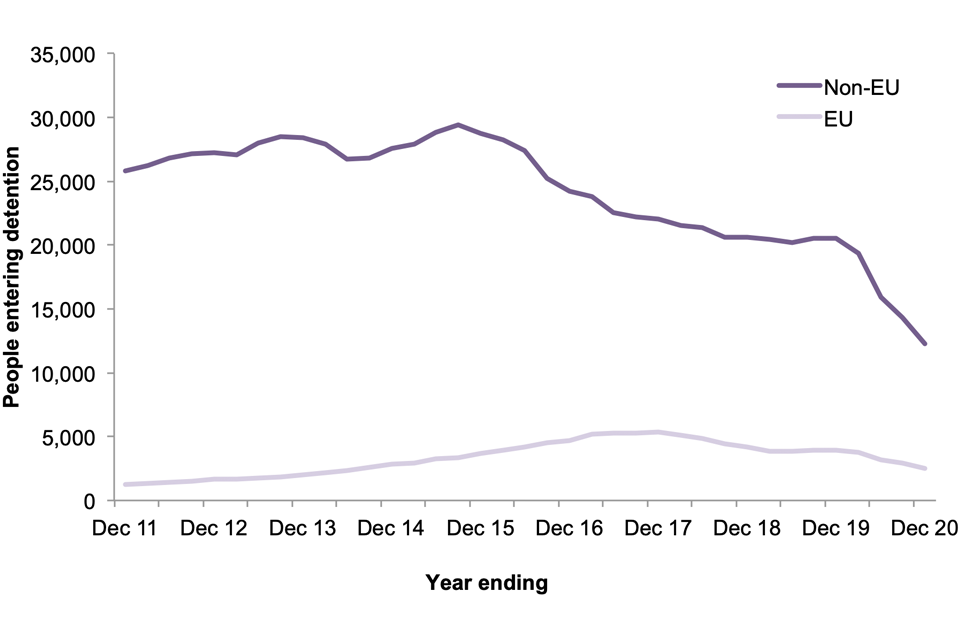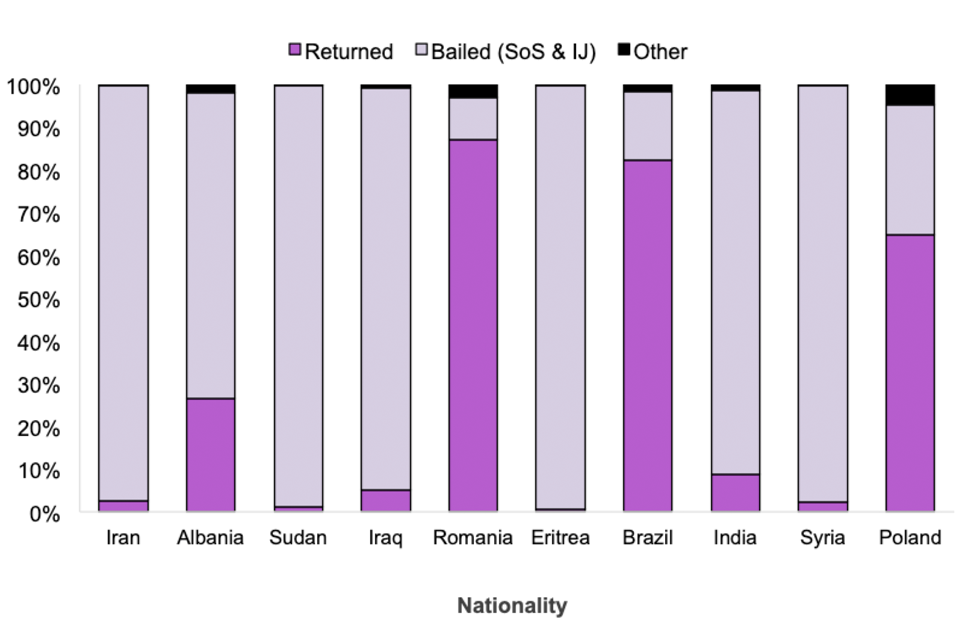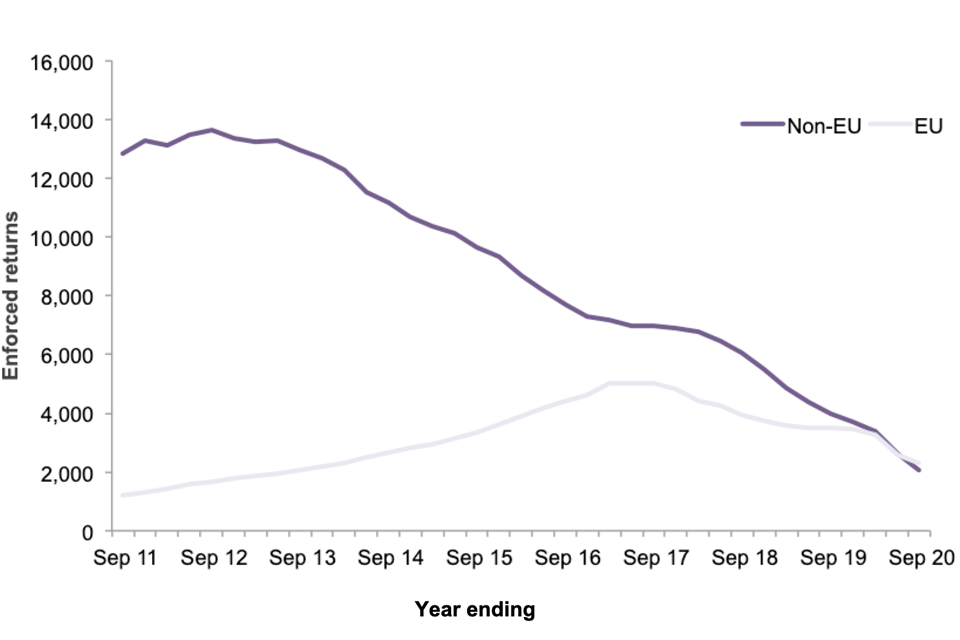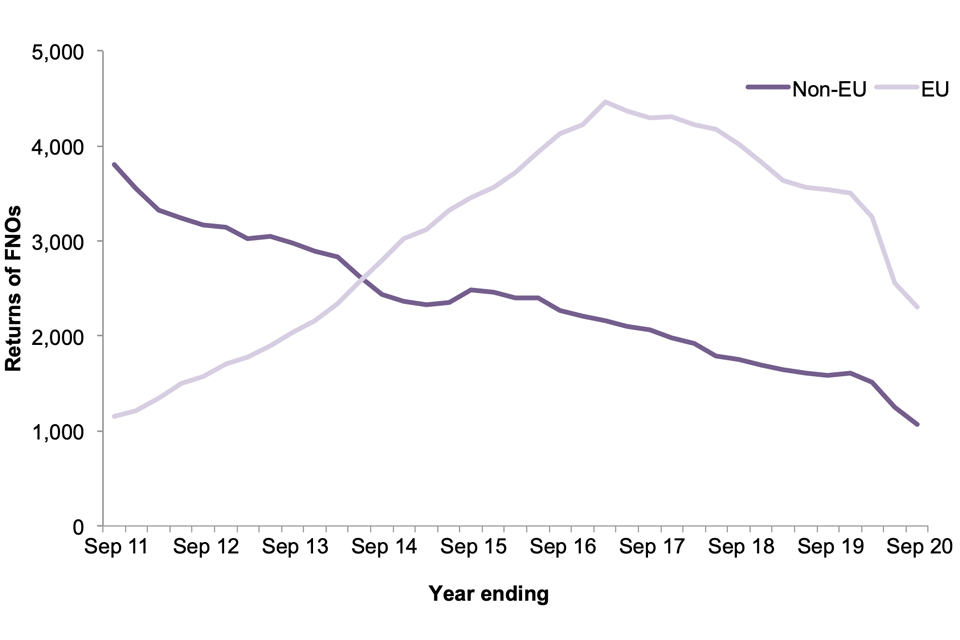How many people are detained or returned?
Published 25 February 2021
Back to ‘Immigration statistics, year ending December 2020’ content page.
This is not the latest release. View latest release.
Data on immigration detention relate to 2020 and all comparisons are with 2019, unless indicated otherwise. Data on returns relate to the year ending September 2020 to allow more time for returns to be recorded on the system and ensure the published figure is an accurate representation of the number of returns. See the user guide for more details.
On 11 March 2020, the World Health Organisation (WHO) declared the COVID-19 outbreak as a global pandemic. A range of restrictions relating to the outbreak began on 12 March 2020, the Foreign and Commonwealth Office (FCO) advised against all non-essential overseas travel on 17 March 2020, and advised all British travellers to return to the UK on 23 March 2020, the same day as the first UK lockdown measures were announced.
Restrictions were put in place across Europe and other parts of the world in the run up to the UK outbreak, which will also have impacted travel to the UK prior to these dates. The COVID-19 pandemic has had a significant impact on the UK immigration system, both in terms of restricting migrant movements to and from the UK and the impact on operational capacity.
Year and year ending comparisons that follow will include impacts resulting from the restrictions put in place during this period of the pandemic. Commentary specifically addressing changes over the course of the pandemic is also provided at the end of each section below.
This section contains data on:
- Individuals detained in the Home Office detention estate and HM Prisons solely under Immigration Act powers
- Returns of people who do not have any legal right to stay in the UK
1. Immigration detention
The number of people entering detention in 2020 was 14,773, 40% fewer than the previous year. There had been a general downward trend in numbers entering detention since 2015 when over 32,000 people entered detention. However, the fall in the latest year has been larger due to the COVID-19 pandemic which has led to fewer people entering detention.
Table 1: People entering, leaving and in detention under immigration powers in the UK, 2019 to 20201
| Year | Entering detention | Leaving detention | In detention 2 |
|---|---|---|---|
| 2019 | 24,480 | 24,544 | 1,637 |
| 2020 | 14,773 | 15,449 | 910 |
| Change: latest year | -9,707 | -9,095 | -727 |
| Percentage change | -40% | -37% | -44% |
Source: Immigration detention – Det_D01, Det_D02 and Det_D03
Note:
- Detained under immigration powers in either the immigration detention estate or a prison.
- Data on those in detention are as at 31 December.
Iranians were the most common nationality entering detention in the latest year, accounting for 13% of the total (1,852), and a 5% increase on the previous year. Albanians were the next most common nationality entering detention, although their number (1,749) was around half that in the previous year. While most other nationalities saw falls in numbers entering, there were increases in the number of Sudanese (914), Eritreans (675) and Syrians (617).
Those that were detained typically spent short periods in detention. Over half (54%) of those who left detention in 2020 were detained for seven days or less, up from between 33% and 39% over the preceding four years. For the key nationalities that saw an increase in numbers (Iran, Eritrea, Sudan and Syria), around 4 in 5 were detained for seven days or less.
Figure 1: People entering detention under immigration powers in the UK, 2011 to 20201

Source: Immigration detention – Det_D01
Notes:
- Prior to July 2017, those entering detention in prisons would not be counted in the entering figures until they entered the detention estate. These cases are now included when entering immigration detention in prison. This means those entering through prisons will be recorded earlier than previously, and those who were not moved from the prison to the detention estate would not previously have been counted.
As at 31 December 2020, there were 910 people in immigration detention, 44% fewer than at 31 December 2019 (1,637), prior to the COVID-19 outbreak. This reduction is due to fewer people being detained in Immigration Removal Centres (IRCs). Although there have been longer-term falls in the number of returns in recent years, the pandemic is likely to have further impacted the ability to secure returns – 4,048 people were returned directly from detention in 2020 (26% of all those leaving detention), down from 9,081 in 2019 (37% of those leaving). In contrast, in 2010 there had been 16,577 returns (64% of those leaving detention).
Nearly three-quarters (72%) of those leaving detention in 2020 were bailed (up from 61% in 2019).
The number of people detained in prisons under immigration powers increased by 45% over the same period from 359 at 31 December 2019 to 519 at 31 December 2020. This may reflect falls in the number of returns, as well as challenges around releasing some foreign national offenders (FNOs) into the community.
Figure 2: People leaving immigration detention, by length of detention1, 2016 to 2020

Source: Immigration detention – Det_D03
Notes:
- Data from July 2017 includes those leaving detention through HM Prisons. Data are not directly comparable with previous years. See the user guide for more details.
- ‘ < ’ means ‘less than’.
Among the top 10 nationalities leaving detention in 2020, there were differences in whether people were granted bail or returned from the UK. For example, 99% (673) of Eritreans and 98% (899) of Sudanese nationals were granted bail. However, 87% (763) of Romanians and 82% (533) of Brazilians were returned from the UK. Changes in the overall proportion of people who receive bail or who are returned from the UK will therefore partly reflect changes in the mix of nationalities who are detained, and any barriers to being returned to their country of origin for people who have no right to remain in the UK.
Figure 3: Top 10 nationalities1 leaving detention by reason for leaving2,3, in 2020

Source: Immigration detention – Det_D03
Notes:
- Top 10 nationalities in the most recent year.
- Bailed (SOS & IJ) Secretary of State & immigration judge.
- Other reasons for leaving detention include being sectioned under the Mental Health Act, entering criminal detention, being granted leave to enter or remain in the UK, and detained in error. See the user guide for more details.
1.1 The effects of COVID-19 on detention
The number of people entering detention in 2020 Q4 was 3,885, 39% less than in 2019 Q4 (6,331), but more than double the number in 2020 Q2 (1,819), around the time of first COVID-19 outbreak in the UK. The increase in 2020 Q4, in part, is due to the short-term detention of clandestine entrants held for initial asylum screening purposes, the majority being detained at a Residential Short-Term Holding Facility at Yarl’s Wood IRC.
Nearly three-quarters (73%) of those leaving detention in 2020 Q4 were granted some form of bail (compared to just 63% in the same period in 2019). Only 26% were returned in 2020 Q4 (compared with 36% in the same period in 2019). In 2020 Q4, 57% of people left detention in 7 days or less compared with 40% in 2020 Q4.
As the circumstances of an individual’s case change, including those resulting from flight restrictions, the suitability of detention is reviewed and release on immigration bail may become the most appropriate option.
2. Returns
In the year ending September 2020, enforced returns from the UK decreased to 4,353, 42% less than the previous year and the lowest number since in the timeseries began in 2004. The fall in enforced returns was largely accounted for by a decrease in enforced returns of people who were in detention prior to their return (down 44% to 2,838). Although the number of enforced returns has been declining since 2013, the fall in the latest year was larger due to very few returns in 2020 Q2 and to a slightly lesser extent 2020 Q3, which was in part affected by the COVID-19 pandemic.
In the year ending September 2020, there were 6,677 voluntary returns, continuing a downward trend since 2016. However, data are not directly comparable over time and the more recent period will be subject to upward revision (see ‘About the statistics’ section).
There were 11,556 passengers who were refused entry at port and subsequently departed, 40% lower than year ending September 2019. The number of port refusals in 2020 Q2 fell significantly as fewer passengers arrived in the UK as a result of the COVID-19 pandemic. The number of port refusals increased slightly in 2020 Q3 as passenger arrivals began to increase, although remains below ‘normal’ levels.
Figure 4: Returns from the UK, by type of return1, year ending September 2011 to year ending September 2020

Source: Returns – Ret_D01
Notes:
- ‘Voluntary returns’ include ‘verified returns’ which are subject to upward revision (particularly for the last 12 months) as in some cases it can take time to identify people who have left the UK without informing the Home Office. Provisional data are denoted with an ‘X’ in the chart.
The number of enforced returns of non-EU nationals had fallen since 2013 from 12,675 to 3,718 in 2019. There has been a further drop to 2,054 in the year ending September 2020 due to the COVID-19 pandemic. Enforced returns of EU nationals also decreased, after peaking at 5,023 in the year ending June 2017, having fallen since then to 2,299 in the year ending September 2020.
These differing trends have meant that the proportion of enforced returns accounted for by EU nationals has increased from 7% in 2010 to 53% in the year ending September 2020.
Figure 5: Enforced returns from the UK, for EU and non-EU nationals1, year ending September 2011 to year ending September 2020

Source: Returns – Ret_D01
Notes:
- EU nationals may be returned for abusing or not exercising Treaty rights, or for deportation on public policy grounds such as criminality.
The top 5 nationalities accounted for 60% of the total enforced returns in the year ending September 2020 – Romania (21%), Albania (15%), Poland (9%), Brazil (9%) and Lithuania (7%). All top 5 nationalities, as for most other nationalities, saw large decreases in enforced returns in the year ending September 2020 compared with the year ending September 2019.
Table 3: Top 5 nationalities1 who had enforced returns2 from the UK, year ending September 2019 and year ending September 2020
| Nationality | Year ending September 2019 | Year ending September 2020 | Change | Percentage Change |
|---|---|---|---|---|
| Romania | 1,292 | 909 | -383 | -30% |
| Albania | 1,004 | 636 | -368 | -37% |
| Poland | 681 | 402 | -279 | -41% |
| Brazil | 518 | 377 | -141 | -27% |
| Lithuania | 431 | 299 | -132 | -31% |
| Other nationalities | 3,636 | 1,730 | -1,806 | -51% |
| Total | 7,462 | 4,353 | -3,109 | -42% |
Source: Returns – Ret_D01
Notes:
- Top 5 nationalities in the most recent year.
- ‘Enforced returns’ cover enforced removals from detention, non-detained enforced removals and other returns from detention where the Home Office will have been required to facilitate or monitor the return.
- ‘Other nationalities’ includes all nationalities that do not feature in the top 5 in the latest year.
Indian nationals were the most common nationality to be recorded having undertaken a voluntary return (1,084, or 16% of the total), followed by Brazilian nationals (604, or 9%) and Pakistani nationals (578, or 9%). These nationalities accounted for around one third (34%) of the total recorded voluntary returns (6,677). This will include only those who were recorded as having left the UK voluntarily after their visa had expired.
The largest number of passengers refused entry at port and who subsequently departed were Brazilian nationals (1,365, or 12% of the total), followed by Albanians (1,087, or 9%) and Romanians (715, or 6%). These three nationalities, which also feature within the top four nationalities for enforced returns, accounted for 27% of the total number of passengers refused entry at port and subsequently departed (11,556).
2.1 Returns of foreign national offenders (FNOs)
The number of FNOs returned saw a steady increase from 2011 to 2016 (4,649 to 6,171) but has fallen slightly since (5,118 returns in 2019). In the year ending September 2020, 3,374 FNOs were returned from the UK, 34% less than the previous year (5,122). These figures are included in the total returns figures and constitute 31% of enforced and voluntary returns, with the majority being enforced returns.
Of the 3,374 FNOs returned from the UK in year ending September 2020:
- around two-thirds (68%) were EU nationals (2,309), a number which includes those who abuse or did not exercise Treaty rights, and those deported on public policy grounds following a conviction for a criminal offence
- around one-third (32%) were non-EU nationals (1,065)
Figure 6: Returns of FNOs1 from the UK, for EU and non-EU nationals, year ending September 2011 to year ending September 2020

Source: Returns – Summary tables
Notes:
- An FNO is someone who is not a British citizen and is/was convicted in the UK of any criminal offence, or abroad for a serious criminal offence.
2.2 The effects of COVID-19 on returns
The number of returns fell for all types of returns in 2020 Q2 compared with the same quarter in 2019. Return numbers have increased in 2020 Q3 but remain lower than the same quarter in 2019. In 2020 Q3 compared with 2019 Q3, enforced returns fell 51% from 1,685 to 832, while the number of voluntary returns (excluding ‘other verified returns’) fell by 47% from 1,201 to 640 and port returns fell by 44% (from 4,440 to 2,495). This fall has coincided with the imposition of travel restrictions as part of the response to the pandemic and significant falls in the number of passengers arriving in the UK (see ‘Statistics relating to passenger arrivals since the COVID-19 outbreak’ for details). Although return numbers have shown a downward trend in recent years, the large falls over the past 6 months are largely related to the restrictions introduced after March 2020. The number of returns fell substantially in April 2020 immediately following the first UK lockdown, and although there were gradual increases into May and through to September 2020, numbers are still below levels seen over same period in previous years.
3. About the statistics
3.1 Immigration detention
The statistics in this section show the number of entries into, and departures from, detention for those held solely under immigration powers. One individual may enter or leave detention multiple times in a given period and will therefore have been counted multiple times in the statistics. Statistics on foreign nationals held in prison for criminal offences are published by the Ministry of Justice in ‘Offender management statistics quarterly’.
The detention estate comprises immigration removal centres (IRC), short-term holding facilities (STHF) and pre-departure accommodation (PDA).
Data on those entering detention, by place of detention, relate to the place of initial detention. An individual who moves from one part of the detention estate to another will not have been counted as entering any subsequent place of detention. The data, therefore, do not show the total number of people who entered each part of the detention estate.
Data on those in detention relate to those in detention on the last day of the quarter.
Data on those leaving detention, by place of detention, relate to the place of detention immediately prior to being released. An individual who moves from one part of the detention estate to another has not been counted as leaving each part of the detention estate. The data, therefore, do not show the total number of people who left each part of the detention estate.
From July 2017, data on detention of immigration detainees in prisons are included in the immigration detention figures. Previously, individuals who were detained in prison would have been recorded in the data upon entering the detention estate through an IRC, STHF or PDA; now they are recorded upon entering immigration detention within prison. As a result, the length of detention of those entering prison prior to July 2017 will be recorded from the point at which they entered an IRC, STHF or PDA. Time spent in prison under immigration powers prior to entering an IRC, STHF or PDA is not included in the length of detention figures prior to July 2017.
For those entering detention from July 2017, the length of detention will include time spent in prison under immigration powers prior to entering an IRC, STHF or PDA. Data from 2017 Q3 onwards are therefore not directly comparable with earlier data. Further details of these changes can be found in the user guide.
Following the introduction of the new Immigration Bail in Schedule 10 of the Immigration Bill 2016, the reason for leaving detention ‘Bailed (SoS)’ replaced the existing powers of ‘granted temporary admission/release’ from 15 January 2018, and ‘Bailed (Immigration Judge)’ replaced ‘Bailed’ to differentiate from ‘Bailed (SoS)’. See the user guide for more details of this change.
Data on the number of children entering detention is subject to change. This will be a result of further evidence of an individual’s age coming to light, such as an age assessment.
Data on deaths in detention include any death of an individual while detained under immigration powers in an IRC, STHF, PDA, under escort, or after leaving detention if the death was as a result of an incident occurring while detained or where there is some credible information that the death might have resulted from their period of detention and the Home Office has been informed. The data are included in table Det_05b in the Detention summary tables. Further details can be found in the user guide.
3.2 Returns
In November 2020, Home Office statisticians revised the published timeseries on returns. The published data now show more voluntary returns and fewer enforced returns than previously published. Further details on the reasons for the revision can be found in the returns section of the user guide.
Data on returns are published a quarter behind to allow more time for returns (particularly ‘other verified returns’) to be entered on the system prior to publication, ensuring that the published data is an accurate representation of the number of returns. We routinely revise the previous eight quarters of data as part of each quarterly release. Therefore, data for the most recent 8 quarters should be considered provisional. Further details on the revisions can be found in the returns section of the user guide.
The statistics in this section show the number of returns from the UK. One individual may have been returned more than once in a given period and, if that was the case, would be counted more than once in the statistics.
The Home Office seeks to return people who do not have a legal right to stay in the UK. This includes people who:
- enter, or attempt to enter, the UK illegally (including people entering clandestinely and by means of deception on entry)
- are subject to deportation action; for example, due to a serious criminal conviction
- overstay their period of legal right to remain in the UK
- breach their conditions of leave
- have been refused asylum
The term ‘deportations’ refers to a legally-defined subset of returns, which are enforced either following a criminal conviction, or when it is judged that a person’s removal from the UK is conducive to the public good. The published statistics refer to enforced returns which include deportations, as well as cases where a person has breached UK immigration laws, and those removed under other administrative and illegal entry powers that have declined to leave voluntarily. Figures on deportations, which are a subset of enforced returns, are not separately available.
Data on voluntary returns are subject to significant upward revision, so comparisons over time should be made with caution. In some cases, individuals who have been told to leave the UK will not notify the Home Office of their departure from the UK. In such cases, it can take some time for the Home Office to become aware of such a departure and update the system. As a result, data for more recent periods will initially undercount the total number of returns. ‘Other verified returns’ are particularly affected by this.
Asylum-related returns relate to cases where there has been an asylum claim at some stage prior to the return. This will include asylum seekers whose asylum claims have been refused and who have exhausted any rights of appeal, those returned under third-country provisions, as well as those granted asylum/protection but removed for other reasons (such as criminality).
Data on the number of people returned from the UK from detention in the ‘immigration detention’ tables includes those who were refused entry at port in the UK who were subsequently detained and then departed the UK. Data on those returned from detention in the ‘returns’ tables do not include those refused entry at port, and so figures will be lower.
Data on returns, and requests for transfer out of the UK under the Dublin Regulation, by article and country of transfer, are available from the Asylum data table Dub_D01. Further details on the Dublin Regulation are set out in the user guide.
EU nationals may be returned for abusing or not exercising Treaty rights, or deported on public policy grounds (such as criminality).
Eurostat publishes a range of enforcement data from EU member states. These data can be used to make international comparisons.
3.3 The Windrush Scheme
The Windrush generation refers to people from Caribbean countries who were invited by the British government between 1948 and 1971 to migrate to the UK as it faced a labour shortage due to the destruction caused by World War II. Not all of these migrants have documentation confirming their immigration status and, therefore, some may have been dealt with under immigration powers.
Data relating to the Windrush compensation scheme are published as part of the Home Office Transparency data.
4. Data tables
Data referred to here can be found in the following tables:
- Immigration detention summary tables
- Detailed immigration detention datasets
- Returns summary tables
- Detailed returns datasets
4.1 Review of immigration enforcement data
The Home Office is reviewing the enforcement data that it publishes to ensure it provides a comprehensive overview of the enforcement system. The Home Office will launch a public consultation to enable users to inform future developments in enforcement statistics in due course.
We welcome your feedback
If you have any comments or suggestions for the development of this report, please provide feedback by emailing MigrationStatsEnquiries@homeoffice.gov.uk. Please include the words ‘PUBLICATION FEEDBACK’ in the subject of your email.
We’re always looking to improve the accessibility of our documents. If you find any problems or have any feedback relating to accessibility, please email us.
See section 7 of the ‘About this release’ section for more details.
